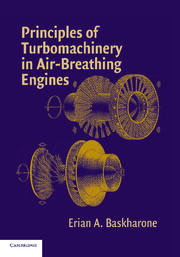Book contents
- Frontmatter
- Contents
- Preface
- 1 Introduction to Gas-Turbine Engines
- 2 Overview of Turbomachinery Nomenclature
- 3 Aerothermodynamics of Turbomachines and Design-Related Topics
- 4 Energy Transfer between a Fluid and a Rotor
- 5 Dimensional Analysis, Maps, and Specific Speed
- 6 Radial-Equilibrium Theory
- 7 Polytropic (Small-Stage) Efficiency
- 8 Axial-Flow Turbines
- 9 Axial-Flow Compressors
- 10 Radial-Inflow Turbines
- 11 Centrifugal Compressors
- 12 Turbine-Compressor Matching
- References
- Index
2 - Overview of Turbomachinery Nomenclature
Published online by Cambridge University Press: 05 September 2012
- Frontmatter
- Contents
- Preface
- 1 Introduction to Gas-Turbine Engines
- 2 Overview of Turbomachinery Nomenclature
- 3 Aerothermodynamics of Turbomachines and Design-Related Topics
- 4 Energy Transfer between a Fluid and a Rotor
- 5 Dimensional Analysis, Maps, and Specific Speed
- 6 Radial-Equilibrium Theory
- 7 Polytropic (Small-Stage) Efficiency
- 8 Axial-Flow Turbines
- 9 Axial-Flow Compressors
- 10 Radial-Inflow Turbines
- 11 Centrifugal Compressors
- 12 Turbine-Compressor Matching
- References
- Index
Summary
A brief introduction to gas-turbine engines was presented in Chapter 1. A review of the different engines, included in this chapter, reveals that most of these engine components are composed of “lifting” bodies, termed airfoil cascades, some of which are rotating and others stationary. These are all, by necessity, bound by the hub surface and the engine casing (or housing), as shown in Figures. 2.1 through 2.5. As a result, the problem becomes one of the internal-aerodynamics type, as opposed to such traditional external-aerodynamics topics as “wing theory” and others. Referring, in particular, to the turbofan engines in Chapter 1 (e.g., Fig. 1.3), these components may come in the form of ducted fans. These, as well as compressors and turbines, can be categorically lumped under the term “turbomachines.” Being unbound, however, the propeller of a turboprop engine (Fig. 1.2) does not belong to the turbomachinery category.
The turbomachines just mentioned, however, are no more than a subfamily of a more inclusive category. These only constitute the turbomachines that commonly utilize a compressible working medium, which is totally, or predominantly, air. In fact, a complete list of this compressible-flow subfamily should also include such devices as steam turbines, which may utilize either a dry (superheated) or wet (liquid/vapor) steam mixture with high quality (or dryness factor). However, there exists a separate incompressible-flow turbomachinery classification, where the working medium may be water or, for instance, liquid forms of oxygen or hydrogen, as is the case in the Space Shuttle Main Engine turbopumps. This subcategory also includes powerproducing turbomachines, such as water turbines.
- Type
- Chapter
- Information
- Publisher: Cambridge University PressPrint publication year: 2006



